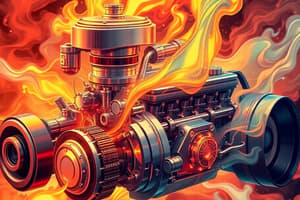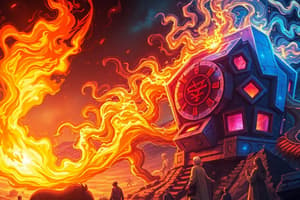Podcast
Questions and Answers
What is the critical rate of application of a fire extinguishing agent dependent on?
What is the critical rate of application of a fire extinguishing agent dependent on?
- The capacity to produce an inert atmosphere
- The capacity to quench Free Radicals (correct)
- The particle size of the extinguishing agent
- The capacity to cool the surrounding area
Why are Dry Chemical Agents not suitable for use in telephone exchanges and computer equipment rooms?
Why are Dry Chemical Agents not suitable for use in telephone exchanges and computer equipment rooms?
- Because they are corrosive
- Because they can render electrical equipment inoperative (correct)
- Because they produce a lasting inert atmosphere
- Because they are not effective against electrical fires
What is the disadvantage of using Dry Chemical Agents in conjunction with water?
What is the disadvantage of using Dry Chemical Agents in conjunction with water?
- It produces a toxic gas
- It creates a corrosive substance
- It is not environmentally friendly
- It reduces the effectiveness of the Dry Chemical Agent (correct)
What property of Dry Chemical Agents prevents them from producing a lasting inert atmosphere?
What property of Dry Chemical Agents prevents them from producing a lasting inert atmosphere?
What is the result of using Dry Chemical Agents in the presence of re-ignition sources?
What is the result of using Dry Chemical Agents in the presence of re-ignition sources?
What is the benefit of using Halon extinguishing agents?
What is the benefit of using Halon extinguishing agents?
What is unique about the flame-inhibiting property of Halon extinguishing agents?
What is unique about the flame-inhibiting property of Halon extinguishing agents?
Which type of Halon is more effective than others?
Which type of Halon is more effective than others?
What is the fourth component of the Fire Tetrahedron?
What is the fourth component of the Fire Tetrahedron?
What is the combustion reaction of Octane with oxygen?
What is the combustion reaction of Octane with oxygen?
According to the Collision Theory, how many molecules can collide simultaneously?
According to the Collision Theory, how many molecules can collide simultaneously?
What is the reason for the reaction of Octane with oxygen not taking place in a single step?
What is the reason for the reaction of Octane with oxygen not taking place in a single step?
What is the characteristic of the products of the first stage of the reaction?
What is the characteristic of the products of the first stage of the reaction?
Why do the products of the first stage of the reaction react immediately in the next stage?
Why do the products of the first stage of the reaction react immediately in the next stage?
What is the result of the reaction of Octane with oxygen in the first stage?
What is the result of the reaction of Octane with oxygen in the first stage?
How does the reaction of Octane with oxygen take place?
How does the reaction of Octane with oxygen take place?
What type of fires are Halons not effective against?
What type of fires are Halons not effective against?
What is the primary mechanism by which Halons extinguish fires?
What is the primary mechanism by which Halons extinguish fires?
What does the first digit in the Halon nomenclature represent?
What does the first digit in the Halon nomenclature represent?
What is the deadline for phase out of Halons in developed countries according to the Montreal Protocol?
What is the deadline for phase out of Halons in developed countries according to the Montreal Protocol?
What is the purpose of creating a Halon bank in the Navy?
What is the purpose of creating a Halon bank in the Navy?
What is the trend in toxicity and extinguishing properties of Halons from F to I?
What is the trend in toxicity and extinguishing properties of Halons from F to I?
What type of atom is not numbered in the Halon nomenclature?
What type of atom is not numbered in the Halon nomenclature?
What international agreement aims to phase out ozone-depleting substances, including Halons?
What international agreement aims to phase out ozone-depleting substances, including Halons?
What is a characteristic of electrically non-conducting fire extinguishing agents?
What is a characteristic of electrically non-conducting fire extinguishing agents?
What is the chemical name of the trade name PFC-410?
What is the chemical name of the trade name PFC-410?
What is the primary way HFC-227ea achieves effective fire extinguishment?
What is the primary way HFC-227ea achieves effective fire extinguishment?
Why is HFC-227ea safe to use on energized electrical equipment?
Why is HFC-227ea safe to use on energized electrical equipment?
What is the trade name of the blend of HydroChloroFluoroCarbons?
What is the trade name of the blend of HydroChloroFluoroCarbons?
Why is R-595 Blend classified as a transitional substance?
Why is R-595 Blend classified as a transitional substance?
What is the chemical name of the trade name FE-13?
What is the chemical name of the trade name FE-13?
How does the volume required for the stowage of HFC-227ea compare to that of Halon 1301?
How does the volume required for the stowage of HFC-227ea compare to that of Halon 1301?
Why are inert gases not suitable for rapidly escalating hydrocarbon fires or explosion inertion in occupied areas of a ship?
Why are inert gases not suitable for rapidly escalating hydrocarbon fires or explosion inertion in occupied areas of a ship?
What is the droplet size of water mist?
What is the droplet size of water mist?
How does water mist combat fires?
How does water mist combat fires?
What happens to the water mist when it absorbs heat from the fire?
What happens to the water mist when it absorbs heat from the fire?
What is an additional benefit of water mist systems?
What is an additional benefit of water mist systems?
Why are water mist fire protection systems complex?
Why are water mist fire protection systems complex?
Where do water mist fire protection systems find application?
Where do water mist fire protection systems find application?
What is an advantage of water mist systems?
What is an advantage of water mist systems?
Flashcards are hidden until you start studying
Study Notes
Free Radicals
- Free Radicals are the fourth component of the Fire Tetrahedron
- They form in the combustion of fuels like Octane, which combines with oxygen to produce carbon dioxide and steam
- The reaction involves multiple stages, not a single step, due to the limited number of molecules that can collide simultaneously
Chain Reaction
- The combustion of Octane involves a chain reaction, with the initial reaction producing highly unstable products with incomplete molecular structures
- These products react immediately in the next stage, completing the reaction in stages
Extinguishing Agents
- The critical rate of application of an extinguishing agent depends on its capacity to quench Free Radicals
- Faster quenching requires less powder to extinguish the fire, and smaller particle size helps cover a larger area
Limitations of Dry Chemical Agents
- Dry Chemical Agents do not produce a lasting inert atmosphere above a flammable liquid's surface
- They should not be used in areas with relays and delicate electrical contacts, as they can render equipment inoperative
- They can be slightly corrosive and should be removed from undamaged surfaces after fire extinguishment
- The use of water and dry chemical agents should be avoided
Halons as an Extinguishing Agent
- Halogenated extinguishing agents are hydrocarbons with one or more hydrogen atoms replaced by atoms from the halogen series
- They are non-flammable, non-toxic, and leave no residue
- Halons create an inert, survivable atmosphere in the compartment, and are effective on Class B, C, and E fires, but less effective on Class A fires
- They are not to be used on Class D fires
Halon Nomenclature
- The first digit of the number represents the number of carbon atoms in the compound molecule
- The second digit represents the number of fluorine atoms, the third digit represents the number of chlorine atoms, and the fourth digit represents the number of bromine atoms
- The fifth digit represents the number of iodine atoms (if any), and hydrogen is not numbered
Halon Substitutes and Alternatives
- The Montreal Protocol has led to the phase out of ozone-depleting substances, including Halons
- The international community has formulated alternatives to Halons, including:
- FC-3-1-10 (PerFluoroButane, C4F10)
- HFC-227ea (HeptaFluoroPropane, CF3CHFCF3)
- R-595 Blend (a blend of HydroChloroFluoroCarbons)
- HFC-23 (TriFluoroMethane, CHF3)
- Water Mist (an environmentally acceptable solution)
Water Mist
- Water Mist is defined as water having a droplet size of 1000 microns
- It combats fires by cooling, oxygen displacement, and radiant heat attenuation
- Water Mist systems are effective, clean, and absorb smoke and irritant gases, making them suitable for various applications, including Turbine Hoods, Flammable Liquid Storage, and Machinery Rooms.
Studying That Suits You
Use AI to generate personalized quizzes and flashcards to suit your learning preferences.




